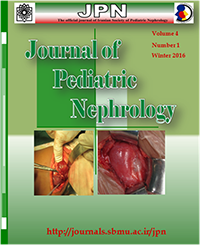The Prevalence of Acute Kidney Injury in Neonates with Asphyxia
Journal of Pediatric Nephrology,
Vol. 4 No. 1 (2016),
13 February 2016
,
Page 30-32
https://doi.org/10.22037/jpn.v4i1.9713
Abstract
Introduction: Asphyxia is a common cause of mortality and morbidity among neonates. Following severe asphyxia and ischemia, reperfusion occurs which damages vital organs like the kidneys. This study was conducted to determine the prevalence of AKI based on the definition of a serum creatinine level higher than 1.5 mg/dL, in neonates with asphyxia.
Materials and Methods: This retrospective study was performed in Ali-Asghar and Shahid-Akbar-Abadi Hospitals, Tehran, Iran in a period of one year. The medical documents of all newborns diagnosed with asphyxia were studied. The asphyxia grade was determined according to the asphyxia Sarnat criteria. The kidney function was evaluated based on the serum creatinine level.
Results: Thirty-eight cases met the inclusion criteria. There were 13 Sarnat grade-1 cases (34.2%), 19 grade 2 cases (50%), and 6 grade 3 patients (17.6%). Three (7.8%) patients (2 patients in grade 3 and one patient in grade 2 of the Sarnat grading scale) developed AKI. AKI was detected in 33% of the patients in grade 3 and 5.2% of the patients in grade 2 of the Sarnat grading scale. Nine patients (23%) died, of whom 83% were in grade 3 and 16.9% in grade 2 of asphyxia.
Conclusions: AKI developed in 7.8% of the cases, of whom 33% were in grade 3 and 5.2% were in grade 2 of the Sarnat grading scale. The low rate of AKI development in our study might be duo to the small sample size and patient mortality in the first 3 days of life.
Keywords: Acute kidney injury; Neonates; Asphyxia.How to Cite
References
World Health Organization. Maternal and Newborn Health/Safe Motherhood. Basic Newborn resuscitation. A practical guide. World Health Organization; Geneva, 1997. http://www.who.int/iris/handle/10665/63953
McGuire W. Perinatal asphyxia. BMJ Clin Evid. 2007 Nov 7;2007. pii: 0320.
Durkan AM, Alexander RT. Acute Kidney Injury Post Neonatal Asphyxia. J Pediatr 2011; 158(2): e29-e33. doi: 10.1016/j.jpeds.2010.11.010.
Subramanian S, Agarwal R, Deorari AK, Paul VK, Bagga A. Acute renal failure in Neonates. Indian J Pediatr. 2008;75:385-391.
Drukker A, Guignard JP. Renal aspects of the term and preterm infant a selective update. Curr Opin Pediatr 2002;14(2):175-82.
Alaro D, Bashir A, Musoke R, Wanaiana L . Prevalence and outcomes of acute kidney injury in term neonates with perinatal asphyxia . Afr Health Sci. 2014; 14(3): 682–688.. doi: 10.4314/ahs.v14i3.26.
Nouri S, Mahdhaoui N, Beizig S, et al . Acute renal failure in full term neonates with perinatal asphyxia. Prospective study of 87 cases. Arch Pediatr 2008;15(3):229-235.doi: 10.1016/j.arcped.2008.01.011.
Karlowicz MG, Adelman RD. Nonoliguric and oliguric acute renal failure in asphyxiated term neonates. Pediatr Nephrol. 1995;9(6):718-722.
Jayashree G, Dutta AK, Sarna MS, Sailli A. Acute renal failure in asphyxiated newborns. Indian Pediatr 1991; 28(1):19-23.
Aldana Valenzuela C, Romaro Maldonado S, Vargas Origel A, Hernández Arriaga J.. Acute complications in full term neonates with severe neonatal asphyxia. Ginecol Obstet Mex. 1995; 63: 123–27.
Perlman JM, Tack ED, Martin T, Shackelford G ,Amon E. Acute systemic organ injury in term infants after asphyxia. Am J Dis Child. 1989; 143(5): 617–20.
Gupta BD, Sharma Bagal J, Parakh M, Soni JP . Renal failure in asphyxiated neonates. Indian Pediatr 2005; 42(9):928-934.
Bhatnagar A, Bairwa AL, Meena KC. Incidence of Acute Kidney Injury in Perinatal Asphyxia and its Correlation with Hypoxic Ischemic Encephalopathy (HIE) staging. PARIPEX-Indian Journal of Research 2014;3(3).12-13
Kaur S, Jain S, Saha A, Chawla D, Parmar VR, Basu S, Kaur J. Evaluation of glomerular and tubular renal function in neonates with birth asphyxia. Ann Trop Paediatr. 2011;31(2):129-34. doi: 10.1179/146532811X12925735813922.
Saboute M, Parvini B, Khalessi N, Kalbassi Z, Kalani M, Khosravi N. Prevalence Acute Kidney Injury in Perinatal Asphyxia. J Ped. Nephrology 2015;3(1) Suppl 1. 12-13
- Abstract Viewed: 825 times
- PDF Downloaded: 352 times

